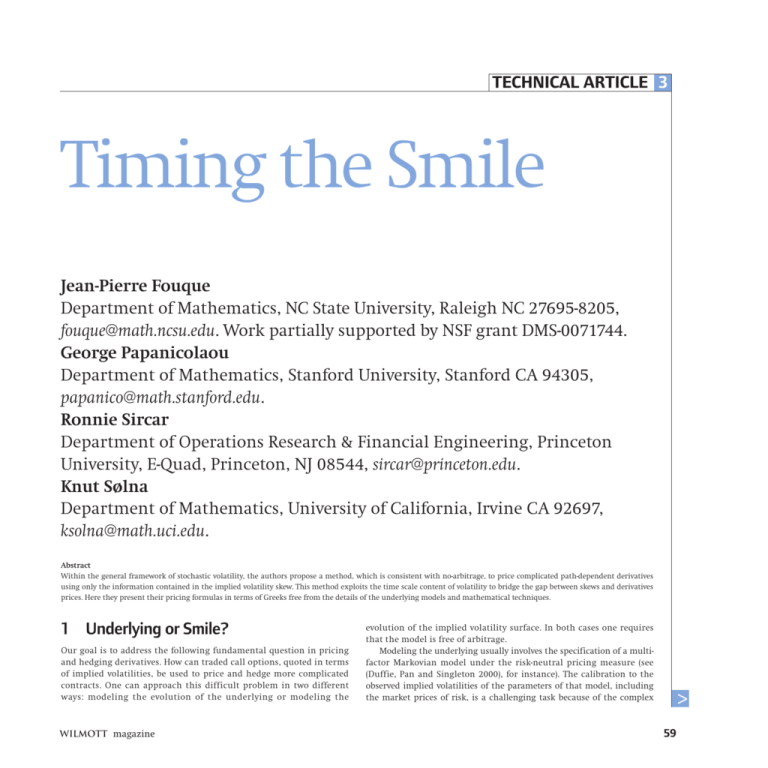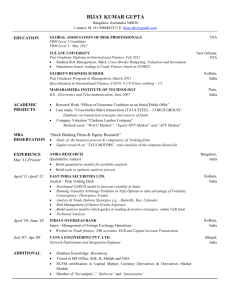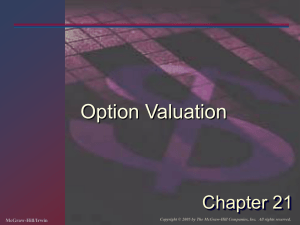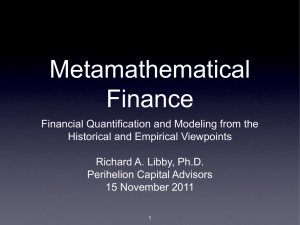TECHNICAL ARTICLE 3 Jean-Pierre Fouque Department of
advertisement

TECHNICAL ARTICLE 3
Timing the Smile
Jean-Pierre Fouque
Department of Mathematics, NC State University, Raleigh NC 27695-8205,
fouque@math.ncsu.edu. Work partially supported by NSF grant DMS-0071744.
George Papanicolaou
Department of Mathematics, Stanford University, Stanford CA 94305,
papanico@math.stanford.edu.
Ronnie Sircar
Department of Operations Research & Financial Engineering, Princeton
University, E-Quad, Princeton, NJ 08544, sircar@princeton.edu.
Knut Sølna
Department of Mathematics, University of California, Irvine CA 92697,
ksolna@math.uci.edu.
Abstract
Within the general framework of stochastic volatility, the authors propose a method, which is consistent with no-arbitrage, to price complicated path-dependent derivatives
using only the information contained in the implied volatility skew. This method exploits the time scale content of volatility to bridge the gap between skews and derivatives
prices. Here they present their pricing formulas in terms of Greeks free from the details of the underlying models and mathematical techniques.
1 Underlying or Smile?
Wilmott magazine
^
Our goal is to address the following fundamental question in pricing
and hedging derivatives. How can traded call options, quoted in terms
of implied volatilities, be used to price and hedge more complicated
contracts. One can approach this difficult problem in two different
ways: modeling the evolution of the underlying or modeling the
evolution of the implied volatility surface. In both cases one requires
that the model is free of arbitrage.
Modeling the underlying usually involves the specification of a multifactor Markovian model under the risk-neutral pricing measure (see
(Duffie, Pan and Singleton 2000), for instance). The calibration to the
observed implied volatilities of the parameters of that model, including
the market prices of risk, is a challenging task because of the complex
59
relation between call option prices and model parameters (through a pricing partial differential equation for instance). A major problem with this
approach is to find the “right model” which will produce a stable parameter estimation. We like to think of this problem as the “(t, T, K)” problem:
for a given present time t and a fixed maturity T , it is usually easy with low
dimensional models to fit the skew with respect to strikes K . Getting a
good fit of the term structure of implied volatility, that is when a range of
observed maturities are taken into account, is a much harder problem
which can be handled with a sufficient number of parameters and eventually including jumps in the model (see (Duffie, Pan and Singleton 2000,
Carr, Geman, Madan 2000) for instance). The main problem remains: the
stability with respect to t of these calibrated parameters. However this is
an highly desirable quality if one wants to use the model to compute noarbitrage prices of more complex path-dependent derivatives, since in this
case the distribution over time of the underlying is crucial.
Modeling directly the evolution of the implied volatility surface is a
promising approach but involves some complicated issues. One has to make
sure that the model is free of arbitrage or, in other words, that the surface is
produced by some underlying under a risk-neutral measure. This is not an
obvious task (see (Cont and da Fonseca 2002) and references therein). The
choice of a model and its calibration is also an important issue in this
approach. But most importantly, in order to use this modeling to price other
path-dependent contracts, one has to identify a corresponding underlying
which typically does not lead to a low dimensional Markovian evolution.
Wouldn’t it be nice to have a direct and simple connection between
the observed implied volatilities and prices of more complex pathdependent contracts! Our objective is to provide such a bridge. This is
done by using a combination of singular and regular perturbations techniques corresponding respectively to fast and slow time scales in volatility.
We obtain a parametrization of the implied volatility surface in terms of
Greeks, which involves four parameters at the first order of approximation. This procedure leads to parameters which are exactly those needed
to price other contracts at this level of approximation. In our previous
work presented in (Fouque, Papanicolaou and Sircar 2000) we used only the
fast volatility time scale combined with a statistical estimation of an effective constant volatility from historical data. The introduction of the slow
volatility time scale enables us to capture more accurately the behavior of
the term structure of implied volatility at long maturities. Moreover in
the framework presented here, statistics of historical data are not needed.
Thus, in summary, we directly link the implied volatilities to prices of
path-dependent contracts by exploiting volatility time scales. We refer to
(Fouque, etal 2003a) for a detailed presentation of volatility time scales in
the S&P 500 index. The mathematical derivation of the combined regular
and singular perturbations can be found in (Fouque, etal 2004b).
2 Volatility Time Scales
Stochastic volatility models can be seen as continuous time versions of
ARCH-type models which have been introduced by R. Engle. The importance
60
of volatility modeling is reflected by the fact that R. Engle has just been
awarded the 2003 Nobel Prize for Economics, shared with C. Granger
whose work also deals with time scale modeling. Our modeling point of
view is that volatility is driven by several stochastic factors running on
different time scales. The presence of these volatility factors is well documented in the literature using underlying returns data (see for instance
(Alizadeh, Brandt and Diebold 2002, Andersen and Bollerslev 1997, Chernov,
etal 2003, Engle and Patton 2001, Fouque, etal 2003a, Hillebrand 2003,
LeBaron 2001, Melino and Turnbull 1990, Mueller, etal 1997)). In fact these
factors play a central role in derivatives pricing and generate in a complex way the term structure of implied volatility. Our perturbative
approach vastly simplifies this complex relation and leads to simple formulas which reflect the main features of the implied volatilities that follow from the effects of these various volatility time scales.
Before going into formulas, we describe in simple words what these
time scales represent and their effects on derivatives pricing.
A stochastic volatility factor running on a slow scale means that it
takes a long time (compared with typical maturities) for this factor to
change appreciably and decorrelate. In the slow scale limit this would
then become a constant volatility factor frozen at the present level. In
this limit, derivatives prices would be obtained by the usual BlackScholes pricing theory at this constant volatility level. Our regular perturbation analysis gives corrections to this limit which affect long
dated options and therefore are reflected in the behavior of the skew at
large maturities. Slow scales, or small perturbations, have been considered in (Fournie, Lebuchoux and Touzi 1997, Lee 1999, Sircar and
Papanicolaou 1999).
A stochastic volatility factor running on a fast scale means that it
takes a short time (compared with typical maturities) for this factor to
come back to its mean level and decorrelate. In the fast scale limit this
would then also become a constant volatility factor at an effective level σ̄
determined by the averaged square volatility
σ̄ 2 ≈
1
T−t
T
σ 2 (s)ds,
(1)
t
the slow volatility factor being frozen, and where we assume that the fast
volatility factor is mean-reverting with rapid mixing properties. Our singular perturbation analysis gives corrections to this Black-Scholes limit
which affect options over various maturities and therefore are reflected
in the behavior of the skew.
The formulas presented below are obtained by assuming that volatility is driven by both slow and fast scale factors. Our analysis, which combines regular and singular perturbations, leads to a parametrization of
the term structure of implied volatility which is valid over a wide range
of maturities. In that sense, to the leading order, we solve the “(T, K) problem”. In fact it turns out that the calibration of our parameters is stable
in time and therefore, to the leading order, we provide a solution to the
full (t, T, K) problem, and we demonstrate that modeling volatility with
Wilmott magazine
TECHNICAL ARTICLE 3
at least two factors (a slow and a fast) is consistent with the behavior of
derivative markets.
3 Volatility Skew Formulas
It is crucial to observe that we can implement this level of price
approximation knowing only the present value, S, and the four parameters σ ∗ , v0 , v1 and v3 . We next show that these parameters in fact can be
estimated from the implied volatilities.
3.1
3.2
Vanilla Prices
Our asymptotic analysis performed on European vanilla options leads to
an explicit formula for the approximated price when the underlying
model has a volatility driven by a slow and a fast factor. The leading order
term, PBS (σ ∗ ), is the classical Black-Scholes price of the contract evaluated
at the constant volatility σ ∗ which will be calibrated from the observed
implied volatilities in Section 3.2. The correction is a combination of
three terms expressed in terms of the Greeks of the Black-Scholes price at
the volatility level σ ∗ :
P ≈ PBS (σ ∗ ) + (T − t) v0 V + v1 S(V) + v3 S(S2 ) ,
(2)
The price approximation given above in the case with European call options
leads to the following approximation of the implied volatility skew:
I(t, S; T, K) ≈ b0 + b1 (T − t) + {m0 + m1 (T − t)} LMMR,
∂PBS ∗
(σ )
∂σ
In fact the coefficients m0 and b0 are due to the fast volatility factor
while the coefficients m1 and b1 are due to the slow volatility factor
which becomes important for large maturities.
Our method now consists of the following steps:
(I) Given a discrete set of implied volatilities I(t, S; Ki , Tj ), we carry out
the linear least squares fits, b + m LMMR , with respect to LMMR for each
time to maturity τj = Tj − t on a given day t. This is illustrated in Figure 1
for six different maturities and for strikes not far out of the money.
(Vega)
∂ 2 PBS ∗
(σ )
(SDelta(Vega) )
∂S∂σ
∂
∂ 2 PBS
(σ ∗ )
S2
(SDelta(S2 Gamma)).
S(S2 ) = S
∂S
∂S2
S(V) = S
V = (T − t)σ S2 ,
Wilmott magazine
Implied Volatility
71 days
0.35
0.5
0.35
0.4
0.3
0.3
0.3
0.25
0.25
0.2
0.2
0.1
0.15
0
0.1
−0.1
−5
0.2
0.15
0.1
0.05
0
LMMR
5
τ = 197 days
−2
0.2
0.25
106 days
0
LMMR
2
288 days
−1
0.24
0.195
0.22
0.2
0.19
0.2
0.15
0.185
0
LMMR
1
379 days
0.18
0.16
−0.5
0
LMMR
0.5
0.18
−0.05
0
LMMR
0.05
−0.2
0
0.2
LMMR
Figure 1: S&P 500 Implied Volatility data on June 5, 2003 and fits to the affine LMMR
approximation (4) for six different maturities
^
and therefore the price approximation can be written in the form
P ≈ PBS (σ ∗ ) + (T − t)v0 V + (T − t)v1 + (v3 /σ ∗ ) S(V).
(3)
τ = 43 days
Implied Volatility
An extensive discussion of the role of the Greeks can be found in
(Haug 2003).
The small parameters (v0 , v1 , v3 ) will also be calibrated from
the observed implied volatilities as we will explain in Section 3.2.
The terms involving v0 and v1 are price corrections that come from
the effect of the slow factor. The term involving v3 is caused by the
fast factor in the volatility and its leverage effect. We remark that
the effective volatility σ ∗ includes a correction that comes from
the market price of fast volatility risk; this volatility level correction could alternatively have been incorporated as a price correction term proportional to S2 Gamma (the apparently missing v2
term). In that sense σ ∗ is a corrected value of the average volatility
σ̄ introduced in (1). The main advantage of introducing σ ∗ is that
it can be estimated from the smile as explained below in Section
3.2. In contrast, σ̄ can only be estimated from long records of historical returns data.
Observe that for European vanilla options we have the explicit
relation:
(4)
where as in (Fouque, Papanicolaou and Sircar 2000) the Log-Moneyness-toMaturity Ratio is defined by
log(K/S)
.
LMMR =
T−t
where S denotes the present value at time t of the underlying, T denotes
the maturity, and the Greeks are given by
V=
Calibrating the Smile
61
We will see in Section 4 that higher order corrections are needed to
capture the turn of the skew as illustrated in Figure 3.
On a given day the above regression gives a pair of estimates of m and b
for each maturity T − t that is available on that day. Next we estimate the
parameters (m0 , b0 ), respectively (m1 , b1 ), by linear regression with respect
to (T − t) of m, respectively b.
In Figure 2 we show the results of these linear regressions on a given
day (June 5, 2003) for the S&P 500 implied volatilities.
3.3
We explain some of the background for the above results and relate this
to deriving pricing equations for rather general contracts. The price
approximation given by the right hand side of (3) can be written
PBS (σ ∗ ) + P1 (σ ∗ )
where the correction P1 (σ ∗ ) is given by:
P1 (σ ∗ ) = (T − t)v0 V + (T − t)v1 + (v3 /σ ∗ t) S(V).
−0.05
The leading order term PBS (σ ∗ ) is the classical Black-Scholes price at
the constant volatility level σ ∗ . It is the solution of the PDE problem
m0 + m1τ
−0.1
−0.15
LBS (σ ∗ )PBS = 0
−0.2
−0.25
0.1
0.2
0.3
0.4
0.5
0.6
τ (yrs)
0.7
0.8
0.9
1
1.1
0.194
0.193
b0 + b1τ
Pricing Equations
0.192
The price correction P1 (σ ∗ ) solves the following partial differential
equation
∂ 2 PBS
∂
∂PBS
∂ 2 PBS
+ 2v1 S
+ v3 S
S2
(σ ∗ ), (6)
LBS (σ ∗ )P1 (σ ∗ ) = − 2v0
∂σ
∂S∂σ
∂S
∂S2
0.191
0.19
0.189
0.188
0.1
with the terminal condition PBS (T, S) = h(S) where h is the payoff function for the European vanilla option that we consider. Recall that the
Black-Scholes operator is given by
1
∂
∂
∂2
+ (σ ∗ )2 S2 2 + r S
−· .
LBS (σ ∗ ) =
∂t
2
∂S
∂S
0.2
0.3
0.4
0.5
0.6
0.7
0.8
0.9
1
1.1
Figure 2: S&P 500 Implied Volatility data on June 5, 2003 and fits to the twoscales asymptotic theory. The bottom (rep. top) figure shows the linear regression
of b (resp. a) with respect to time to maturity τ = T – t
with a zero terminal condition P1 (σ ∗ )(T, S) = 0 . In terms of the Greeks
introduced in (2) this equation reads
LBS (σ ∗ )P1 (σ ∗ ) = − 2v0 V + 2v1 S(V) + v3 S(S2 )
(7)
where again the Greeks are evaluated at the effective volatility σ ∗ .
(II) The parameters σ ∗ , v0 , v1 and v3 that are needed for pricing are
given explicitly by the following formulas:
σ ∗ = b0 + m 0
b2
r− 0
2
b2
v0 = b1 + m 1 r − 0
2
(5)
v1 = m1 b20
v3 = m0 b30
Observe that in the regime that our approximation is valid the parameters v0 , v1 and v3 are expected to be small, while σ ∗ is the leading order
volatility. This is what we see on Figure 2 for S&P 500 on June 5, 2003.
Here, r is the short rate which we assume to be known and constant.
62
3.4
Pricing Exotic Contracts
We are now in a position to carry out our main task, that is, with the
parameters calibrated from the smile we will price more general contracts than just the vanilla cases considered above. The pricing procedure
is simply:
1. Compute the leading order (Black-Scholes) price P0 (σ ∗ )which is the
price of the contract at the constant volatility level σ ∗ defined in (5).
This involves solving partial differential equations with appropriate
boundary and terminal conditions.
2. Compute the Greeks V, S(V), S(S2 ) of the price P0 (σ ∗ ) of the
exotic contract.
3. Compute the price correction P1 (σ ∗ ) by solving the same pricing
problem as in Step 1 for P0 (σ ∗ ) with the constant volatility σ ∗ , but
Wilmott magazine
TECHNICAL ARTICLE 3
with a zero payoff and with a source, as given in (7), defined in
terms of the computed Greeks and the three parameters v0 , v1 and v3
that are calibrated from the skew as explained in section 3.2.
4. The price is now given by correcting the leading order price:
P ≈ P0 (σ ∗ ) + P1 (σ ∗ ).
parameters increases (from four to eleven), higher order Greeks are
involved (up to sixth order derivatives) and consequently the computational cost also increases.
The upshot of a long calculation that includes the next three (secondorder) terms in the combined fast and slow scales expansion, is that, outside of a small terminal layer (very close to expiration), implied volatilities are approximated by
We present next some remarks regarding the above procedure.
∗
• For complicated contracts, computing the price P0 (σ )along with the
Greeks usually requires numerical methods (finite differences,
Monte Carlo,..) depending on the nature of the contract. We do not
comment on the details of these numerical methods. These methods
are well documented elsewhere (see for instance (Wilmott 2000)),
what is important to note is that in this framework they only need to
be applied in a setting with a constant volatility.
• Solving the problem for the correction P1 requires generalizations of
these methods to the case with a source term. The authors have explicitly considered some of these problems (Asian, Barriers, American,. . .)
in (Fouque, Papanicolaou and Sircar 2000) with only the fast scale, and
in (Fouque, etal 2004b) and the forthcoming book (Fouque, etal 2004c)
with both fast and slow scales. Note that for American options the free
boundary is determined by solving the problem for P0 (σ ∗ ) and it is
then used as a fixed boundary in the problem with a source that
determines P1 (σ ∗ ).
4 Further Corrections
Observe that above we used a leading order expansion of the price in
the context of a multifactor stochastic volatility to obtain a connection between the implied volatility skew and pricing formulas. The
mathematical tools underlying the approximation (6) consists in writing first a class of stochastic volatility models containing fast and slow
volatility factors. We then expand the corresponding pricing equations with respect to the small parameters defining these two time
scales: one parameter being the time scale of the fast factor and the
other being the reciprocal of the time scale of the slow factor. The formulas above constitute the first order approximation with respect to
these parameters.
A natural extension of this approach is to include further terms of the
asymptotic expansion. In particular, as the first-order terms describe
affine skews (as a function of log-moneyness), but often we observe slight
turns (or wings) at extreme strikes, we consider the next set of terms,
which turn out to allow for skews that are quartic polynomials in logmoneyness. By including these terms we improve the quality of the fit to
the skew and the accuracy of the pricing formulas. Indeed the number of
I≈
4
j=0
aj (τ ) (LM)j +
1
t ,
τ
(8)
where τ denotes the time-to maturity T − t, LM denotes the moneyness
log(K/S), and t is a rapidly changing component that varies with the
fast volatility factor. In (8) we choose to separate the log-moneyness and
the maturity dependence. Alternatively we could have written the
implied volatility as a polynomial in LMMR as we did in (4) for the first
order approximation.
Again, this calibration formula is employed in a two-stage fitting procedure that recognizes the thinness of data in the maturity dimension,
relative to the many available strikes. On each day, the skew for each
available maturity is fit to a quartic polynomial in log-moneyness to
obtain estimates of a1 (τ ), a2 (τ ), a3 (τ ) and a4 (τ ) for those τ that are
observed on that day. The a0 estimates include the small component t ,
and we discuss only the a1 , · · · , a4 fits here.
Figure 3 shows some typical quartic fits of S&P 500 implied
volatilities for a few maturities. Here we use a wider range of strikes
than in the linear fit shown in Figure 1, in particular in the out of
the money direction. We see from these plots that the quartic produced by the second order approximation becomes important in
capturing the turn of the skew. In these fits, it is important to fit
the main body of the skew to an affine function of log-moneyness
first (corresponding to the first order approximation presented in
Section 3.2), and then fit the remainder
I − (a0 + a1 (LM))
(LM)2
to a quadratic in moneyness LM (in practice, LM is shifted to LM + 1 to
avoid divide-by-zero issues). This split procedure is necessary because
a free one-stage fit often uses the freedom of the quartic to catch
stray data points, leading to large estimates of a3 and a4 . By viewing
the wings as small corrections to the linear skew, we avoid “tail wagging the dog” phenomena.
Then, we fit the quartic coefficients to the following term-structure
formulas coming from the asymptotics:
^
Wilmott magazine
63
5 June, 2003: S&P 500 Options,
71 days to maturity
0.5
0.5
0.45
0.45
Implied Volatility
Implied Volatility
5 June, 2003: S&P 500 Options,
15 days to maturity
0.4
0.35
0.3
0.25
0.2
a1 (τ ) =
a2 (τ ) =
0.4
1
0.35
k=− 2
0.3
0
a2,k τ k
(9)
a3 (τ ) =
0.25
a3,k τ k
k=− 1
0.15
0.3 0.4 0.5 0.6 0.7 0.8 0.9 1 1.1 1.2 1.3
Log-Moneyness + 1
Log-Moneyness + 1
5 June, 2003: S&P 500 Options,
197 days to maturity
a1,k τ k
k=− 1
0.2
0.15
0.75 0.8 0.85 0.9 0.95 1 1.05 1.1 1.15
2
a4 (τ ) =
−1
a4,k τ k .
k=− 2
5 June, 2003: S&P 500 Options,
379 days to maturity
The calibrated parameters {aj,k } play the role played by
(b0 , b1 , m0 , m1 ) in the first-order theory.
0.22
Figure 4 shows the fits of the a(τ )’s to their term-structure
0.26
0.21
formulas for S&P 500 data on June 5, 2003.
0.24
0.2
As discussed in the introduction, one of the main issues in
0.22
volatility calibration is the stability with respect to t of the
0.19
0.2
parameter estimates. To illustrate this point we carried out the
0.18
0.18
quartic fits on S&P 500 implied volatilities collected over the
0.17
course of a month, We obtain estimates of a1 (τ ), a2 (τ ), a3 (τ )
0.16
0.16
and a4 (τ ) for those τ that are observed over this period. Figure
0.14
0.15
0.8 0.9
1 1.1 1.2 1.3 1.4 1.5
0.75 0.8 0.85 0.9 0.95 1 1.05 1.1 1.15 1.2
5 shows the fits of a1 , · · · , a4 to their corresponding term-strucLog-Moneyness + 1
Log-Moneyness + 1
ture formulas given in (9). The reasonable fits shown in Figure
5, using a month’s data demonstrate the stability of the approxFigure 3: S&P 500 Implied Volatility data on June 5, 2003 and quartic fits to the asympimation over some time. We remark that the a1 estimates
totic theory for four maturities
become less structured at small maturities because of a period4
8
ic maturity cycle component due to the option expiration (‘witching’)
dates the third Friday of each month. This is studied in detail in (Fouque,
3
6
etal 2004a).
The final step is to recover the parameters needed for pricing from
2
4
the estimates of {aj,k }, the analog of (5) in the first-order theory. However,
1
2
these relations are no longer linear in the second-order theory, and a
nonlinear inversion algorithm is required. This aspect has to be treated
0
0
case by case in order to take advantage of the particular features of the
0
0.5
1
1.5
2
0
0.5
1
1.5
2
τ (yrs)
τ (yrs)
market under study. For instance in FX markets, the correlation between
the underlying and its volatility tends to be zero which reduces the com5
0
plexity of the implementation of the second order theory.
4
0.28
a4
a3
Implied Volatility
Implied Volatility
0.23
−0.1
a1
a2
3
2
−0.3
1
−0.4
0
−1
−0.2
0
0.5
1
τ (yrs)
1.5
2
−0.5
0
0.5
1
τ (yrs)
1.5
2
Figure 4: S&P 500 Term-Structure Fit using second order approximation.
Data from June 5, 2003
64
Wilmott magazine
TECHNICAL ARTICLE 3
8
20
6
15
a3
25
a4
10
4
10
2
5
0
0.5
τ (yrs)
1
0
1.5
12
0
10
−0.1
8
−0.2
a1
a2
0
6
0.5
0
0.5
τ
1
1.5
1
1.5
−0.3
−0.4
4
−0.5
2
−0.6
0
0
0
0.5
1
τ
1.5
−0.7
τ
Figure 5: S&P 500 Term-Structure Fit. Data from every trading day in May 2003
REFERENCES
■ S. Alizadeh, M. Brandt, and F. Diebold. Range-based estimation of stochastic volatility
models. Journal of Finance, 57(3): 1047–91, 2002.
■ T. Andersen and T. Bollerslev. Intraday periodicity and volatility persistence in financial
markets. J. Empirical Finance, 4: 115–158, 1997.
■ G. Bakshi, C. Cao and Z. Chen. Empirical Performance of Alternative Option Pricing
Models. Journal of Finance, 52(5): 2003–2049, 1997.
■ P. Carr, H. Geman, D. Madan, M. Yor. The fine structure of asset returns: An empirical
investigation, working paper, 2000.
■ M. Chernov, R. Gallant, E. Ghysels, and G. Tauchen. Alternative models for stock price
dynamics, 2001 preprint, to appear in J. of Econometrics, 116: 225–257, 2003.
■ R. Cont and J. da Fonseca. Dynamics of implied volatility surfaces. Quantitative Finance,
2(1): 45–60, 2002.
■ D. Duffie, J. Pan, and K. Singleton. Transform analysis and option pricing for affine
jump-diffusions. Econometrica, 68: 1343–1376, 2000.
■ R. Engle and A. Patton. What good is a volatility model? Quantitative Finance, 1:
237–245, March 2001.
■ J. P. Fouque, G. Papanicolaou, and K.R. Sircar. Derivatives in Financial Markets with
Stochastic Volatility. Cambridge University Press, 2000.
■ J. P. Fouque, G. Papanicolaou, K.R. Sircar and K. Solna. Maturity Cycles in Implied
Volatility. To appear in Finance & Stochastics, 2004a.
■ J.-P. Fouque, G. Papanicolaou, K.R. Sircar, and K. Solna. Short Time-Scale in S&P 500
Volatility. Journal of Computational Finance, 6(4): 1–23, 2003a.
■ J.P. Fouque, G. Papanicolaou, K.R. Sircar and K. Solna. Singular Perturbations in Option
Pricing. SIAM J. Applied Math., 63(5): 1848–1665, 2003b.
Wilmott magazine
■ J.P. Fouque, G. Papanicolaou, K.R. Sircar and K. Solna. Multiscale Stochastic Volatility
Asymptotics. To appear in SIAM Journal Multiscale Modeling and Simulation, 2004b.
■ J.P. Fouque, G. Papanicolaou, K.R. Sircar and K. Solna. Volatility Perturbations in
Financial Markets. In preparation, 2004c.
■ E. Fournie, J. Lebuchoux, and N. Touzi. Small Noise Expansion and Importance
Sampling. Asymptotic Analysis, 14(4): 361–376, 1997.
■ E.G. Haug. Know Your Weapon, Parts 1 and 2. Wilmott, May and August 2003.
■ E. Hillebrand, Overlaying Time Scales and Persistence Estimation in GARCH(1,1) Models.
Preprint 2003.
■ B. LeBaron. Stochastic volatility as a simple generator of apparent financial power
laws and long memory. Quantitative Finance, 1(6): 621–631, November 2001.
■ R. Lee, Local volatilities under stochastic volatility. International Journal of Theoretical
and Applied Finance 4(1): 45–89, 1999.
■ A. Lewis. Option Valuation under Stochastic Volatility. Finance Press, Newport Beach,
CA, 2000.
■ A. Melino and S. Turnbull. Pricing foreign currency options with stochastic volatility. J.
Econometrics, 45: 239–265, 1990.
■ U. Mueller, M. Dacorogna, R. Dave, R. Olsen, O. Pictet, and J. von Weizsacker.
Volatilities of different time resolutions — analyzing the dynamics of market components.
J. Empirical Finance, 4(2-3): 213–239, June 1997.
■ K.R. Sircar and G. C. Papanicolaou, Stochastic Volatility, Smile and Asymptotics. Applied
Mathematical Finance, 6(2): 107–145, 1999.
■ P. Wilmott. Paul Wilmott on Quantitative Finance. Volume 2, John Wiley & Sons, 2000.
W
65


![[These nine clues] are noteworthy not so much because they foretell](http://s3.studylib.net/store/data/007474937_1-e53aa8c533cc905a5dc2eeb5aef2d7bb-300x300.png)






